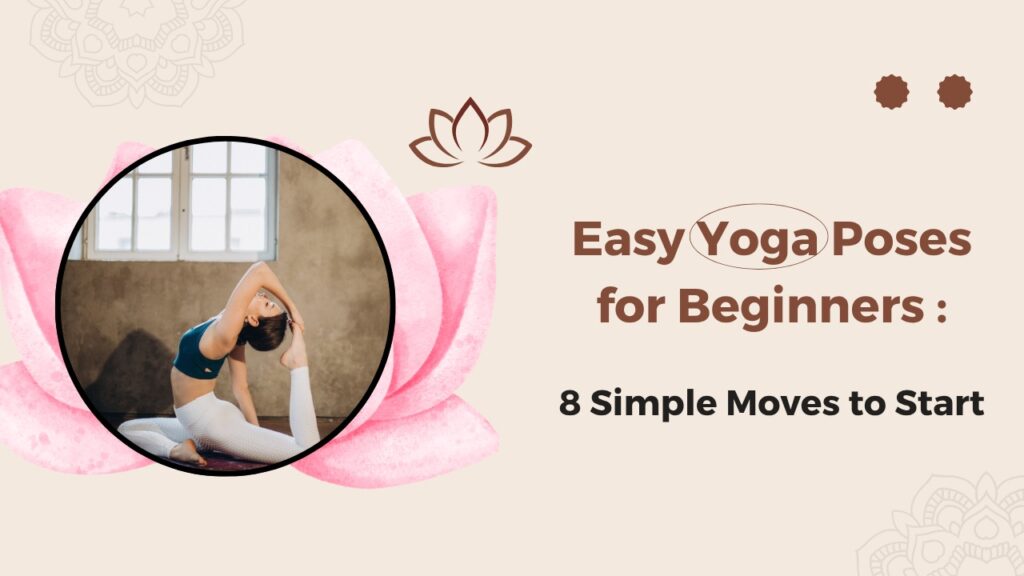Yoga is not just a form of exercise—it’s a complete system that connects your body, mind, and spirit. It encourages a sense of peace, focus, and overall well-being. For those new to the practice, yoga offers a gentle way to ease into physical movement while also calming the mind.
Starting with easy yoga poses is the best way to begin your journey. These beginner-friendly postures help improve flexibility, build balance, and enhance mental clarity. They are simple enough for anyone to try, making the practice feel welcoming rather than intimidating. Regular practice can bring both physical and emotional benefits.
Whether you’re trying yoga for the first time or returning after a break, learning the right poses can make a big difference. This guide introduces the top 8 easy yoga poses perfect for beginners. Each one is chosen to support your growth, help you stay motivated, and create a strong foundation for future practice.
This article explores each pose in detail, including step-by-step instructions, benefits, modifications, and tips for practice. By the end, you’ll have a solid foundation in yoga and the confidence to build a consistent, enriching routine.
Introduction to Yoga for Beginners
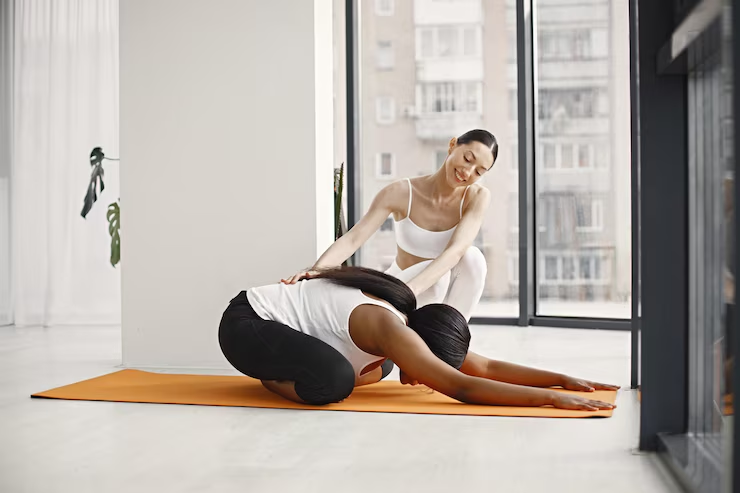
Yoga began in ancient India more than 5,000 years ago and has grown into a global practice with many different styles. Its long history shows how effective and adaptable it is for people from all walks of life. Today, yoga continues to offer benefits for the body and mind through simple, mindful movements.
For beginners, one of the best parts of yoga is how flexible the practice itself can be. Easy yoga poses can be adjusted to match your needs, no matter your body type, age, or fitness level. This makes yoga a welcoming choice for anyone wanting to start a new wellness routine.
Practicing easy yoga poses regularly helps you stretch and move in a gentle way, which improves flexibility and balance. At the same time, these poses also support deep breathing and mental calmness, reducing everyday stress.
Whether your goal is to relax, become more flexible, or create healthier habits, yoga gives you simple tools to make a real difference. With patience and practice, it can become a rewarding part of your life.
Why Start with Easy Poses ?
Starting with easy yoga poses provides several advantages:
Reduces the risk of injury by avoiding complex postures too soon.
Builds foundational strength to support advanced poses later.
Increases flexibility gradually and safely.
Encourages body awareness, breath control, and mindfulness.
Boosts confidence by allowing you to feel successful early on.
With consistent practice, these beginner poses will become the building blocks for a deeper yoga journey.
Top 8 Easy Yoga Poses
Mountain Pose (Tadasana)
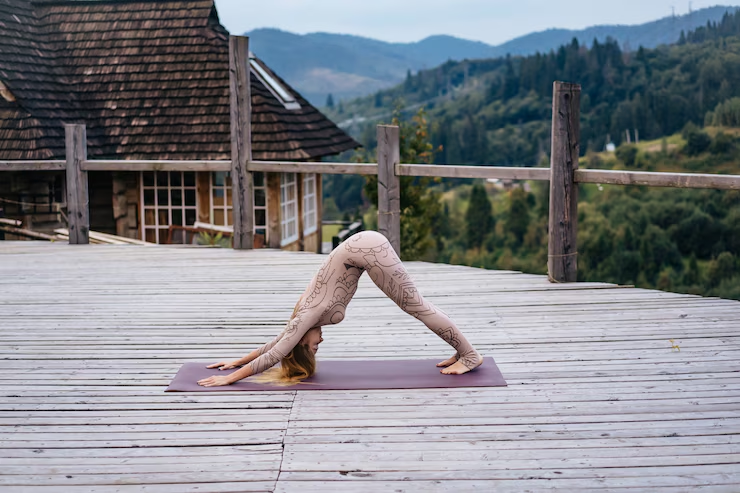
Mountain Pose, also known as Tadasana, is one of the foundational easy yoga poses for beginners. Though it looks simple, it teaches the importance of posture, balance, and body awareness. It is often used as a starting point for other standing poses.
To practice Mountain Pose, stand tall with your feet together and arms by your sides. Keep your weight evenly distributed on both feet, engage your thighs, lift your chest, and reach your arms upward or keep them at your sides. Focus on your breath and hold the pose for a few breaths while standing still and strong.
Mountain Pose helps improve posture, strengthens the legs, and encourages a calm, steady mind. As one of the most basic yet powerful easy yoga poses, it builds a strong foundation for your yoga journey and encourages mindfulness through simple, focused standing.
Purpose: Improves posture and awareness; the starting point for most standing poses.
How to do it
Stand tall with feet together or hip-width apart.
Distribute your weight evenly on both feet.
Engage your thighs and pull your belly button slightly in.
Let your arms hang by your sides or raise them overhead with palms facing each other.
Breathe deeply, keeping your spine long and shoulders relaxed.
Benefits
Enhances posture
Strengthens thighs, knees, and ankles
Encourages groundedness and balance
Tips
Practice in front of a mirror to check alignment.
Focus on lifting through the crown of the head.
Cat-Cow Pose (Marjaryasana-Bitilasana)
Cat-Cow Pose, known as Marjaryasana-Bitilasana, is a gentle flow between two poses that warms up the spine and relaxes the mind. It is one of the most popular and effective easy yoga poses for beginners, especially at the start of a yoga session.
To practice, begin on your hands and knees in a tabletop position. Inhale as you drop your belly, lift your chest, and gaze up for Cow Pose. Exhale as you round your spine, tuck your chin, and draw your belly in for Cat Pose. Repeat this movement slowly, matching your breath to the motion.
This pose increases flexibility in the spine, improves posture, and helps release tension in the neck and back. Cat-Cow is one of the best easy yoga poses to gently awaken the body, improve circulation, and calm the mind, making it ideal for daily practice.
Purpose: Warms up the spine and increases flexibility in the neck and back.
How to do it
Come onto your hands and knees in a tabletop position.
For Cow Pose: Inhale, drop your belly, lift your head and tailbone.
For Cat Pose: Exhale, round your spine, tuck your chin and pelvis.
Move slowly between the two, coordinating with your breath.
Benefits
Enhances spinal flexibility
Relieves back tension
Improves coordination and breath control
Tips
Keep movements slow and fluid.
Engage your core throughout the flow.
Downward-Facing Dog (Adho Mukha Svanasana)
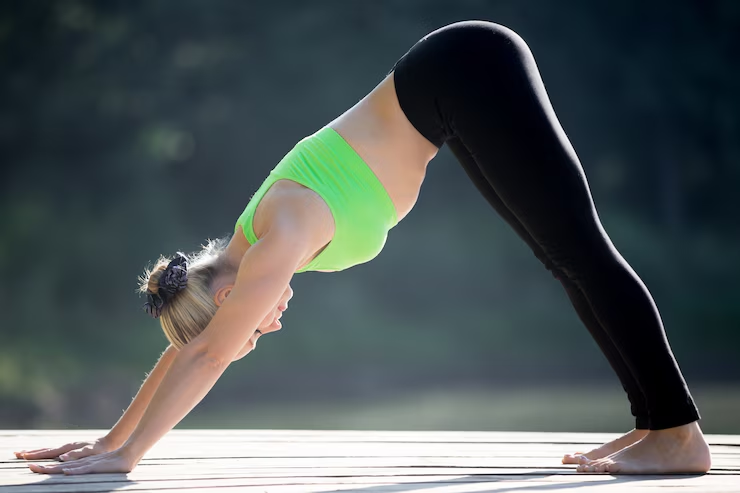
Downward-Facing Dog, or Adho Mukha Svanasana, is one of the most recognized and effective easy yoga poses. It helps stretch the entire body while building strength and improving circulation. Though it may feel challenging at first, it becomes more comfortable with regular practice.
To begin, start on your hands and knees. Tuck your toes, lift your knees, and raise your hips toward the ceiling, forming an inverted V shape. Keep your hands shoulder-width apart and feet hip-width apart. Press your hands and heels toward the floor while keeping your spine long.
This pose stretches the back, legs, and shoulders while energizing the body. It also calms the mind and can help relieve stress. Among easy yoga poses, Downward-Facing Dog is perfect for improving flexibility and strength, making it a great addition to any beginner’s yoga routine.
Purpose: Full-body stretch that builds strength and enhances circulation.
How to do it
From tabletop, tuck your toes and lift your hips up and back.
Form an inverted V shape with your body.
Keep your hands shoulder-width apart, fingers spread wide.
Feet should be hip-width apart with heels moving toward the floor.
Hold for 3–5 breaths.
Benefits
Stretches the hamstrings, calves, and shoulders
Strengthens arms and legs
Energizes and improves blood flow
Modifications
Bend your knees slightly if hamstrings are tight.
Use a folded blanket under heels if needed.
Child’s Pose (Balasana)
Child’s Pose, or Balasana, is a restful posture often used during yoga sessions to relax and reset. It is one of the most comforting and restorative easy yoga poses, making it perfect for beginners. This pose gently stretches the back, hips, and shoulders while calming the nervous system.
To practice Child’s Pose, kneel on the floor with your big toes touching and knees spread apart. Sit back on your heels and slowly fold forward, placing your forehead on the mat and arms stretched forward or resting by your sides. Breathe deeply and stay in the pose as long as you feel comfortable.
This gentle stretch helps relieve tension in the lower back and neck. It also encourages deep breathing and a sense of peace. As one of the most soothing easy yoga poses, Child’s Pose is ideal for rest, reflection, and stress relief during your yoga practice.
Purpose: A resting pose that gently stretches the hips, thighs, and back.
How to do it
Kneel on the mat with big toes touching and knees apart.
Sit back on your heels.
Fold forward, bringing your forehead to the mat.
Stretch arms forward or place them alongside your body.
Benefits
Relieves tension in the back, neck, and shoulders
Calms the mind
Encourages introspection and relaxation
Tips
Place a cushion under your chest or forehead for comfort.
Use as a resting pose between more challenging postures.
Cobra Pose (Bhujangasana)
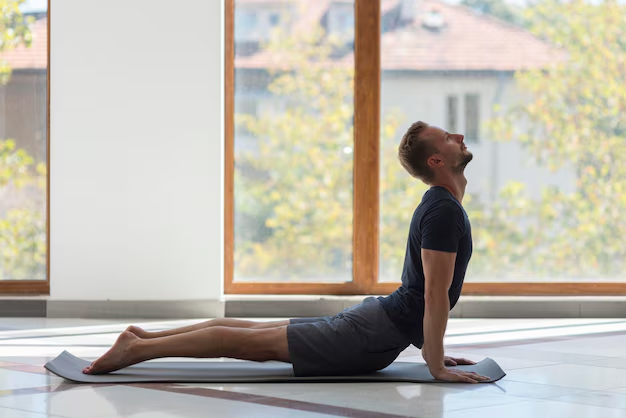
Cobra Pose, or Bhujangasana, is a gentle backbend that strengthens the spine and opens the chest. It’s one of the helpful easy yoga poses for beginners, especially those looking to improve posture and flexibility in the upper body. This pose also helps relieve tension in the lower back.
To practice Cobra Pose, lie flat on your stomach with your legs extended and hands placed under your shoulders. Press your palms into the mat, keep your elbows close to your body, and gently lift your chest as you inhale. Keep your lower body grounded and avoid overextending the back.
Cobra Pose stretches the front of the body and improves spinal flexibility. It also opens the heart and lungs, encouraging deep breathing. Among easy yoga poses, Cobra is a safe and energizing posture that supports back health and adds strength to your core and upper body.
Purpose: Strengthens the spine and opens the chest and lungs.
How to do it:
Lie face down with palms under shoulders and elbows close to your body.
Inhale and gently lift your chest off the ground.
Keep your pelvis and legs grounded.
Avoid overextending the lower back.
Benefits:
Stimulates abdominal organs
Reduces fatigue and stress
Improves posture
Tips:
Keep elbows bent for low cobra or straighten arms slightly for deeper stretch.
Engage glutes and thighs gently.
Bridge Pose (Setu Bandhasana)
Bridge Pose, or Setu Bandhasana, is a gentle backbend that strengthens the back, legs, and glutes while opening the chest and shoulders. It’s one of the most supportive and effective easy yoga poses, especially for beginners who want to improve posture and reduce back discomfort.
To practice Bridge Pose, lie on your back with your knees bent and feet flat on the floor, hip-width apart. Keep your arms by your sides with palms facing down. As you inhale, press your feet into the mat and lift your hips toward the ceiling, creating a straight line from shoulders to knees.
Bridge Pose helps stretch the spine, chest, and hip flexors. It also stimulates the lungs and improves blood flow. As one of the foundational easy yoga poses, it provides both strength and relaxation, making it a great choice for building body awareness and relieving stress.

Purpose: Opens the chest, strengthens the back, and energizes the body.
How to do it
Lie on your back with knees bent, feet hip-width apart.
Press feet into the floor and lift your hips toward the ceiling.
Clasp hands under your back or keep arms flat.
Breathe and hold for 3–5 breaths.
Benefits
Strengthens glutes, hamstrings, and lower back
Opens the chest and shoulders
Improves digestion and circulation
Modifications
Place a block under your sacrum for a supported bridge.
Seated Forward Bend (Paschimottanasana)
Seated Forward Bend, or Paschimottanasana, is a calming pose that stretches the entire back of the body, especially the spine, hamstrings, and calves. It is one of the gentle and effective easy yoga poses that promote flexibility and relaxation, making it perfect for beginners.
To do this pose, sit with your legs extended straight in front of you. Inhale to lengthen your spine, then exhale as you slowly bend forward from the hips, reaching for your feet or shins. Keep your back as straight as possible and focus on your breath to deepen the stretch.
This pose helps reduce stress, calm the mind, and improve digestion. It also eases tension in the lower back and legs. As one of the most soothing easy yoga poses, Seated Forward Bend is ideal for ending a yoga session with stillness and mindfulness while gently improving flexibility.
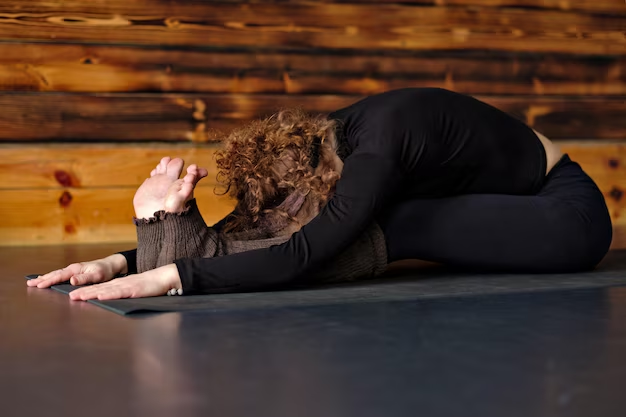
Purpose: Stretches the spine, hamstrings, and lower back while calming the mind.
How to do it
Sit with legs extended straight in front of you.
Inhale and lengthen your spine.
Exhale as you fold forward from the hips.
Reach for your feet, ankles, or shins—wherever you can comfortably reach.
Benefits
Improves flexibility in hamstrings and spine
Stimulates internal organs
Reduces anxiety and fatigue
Tips
Use a strap around your feet if you can’t reach them.
Bend knees slightly to avoid straining the lower back.
Tips for a Successful Yoga Practice
Consistency matters: Practicing even 10 minutes daily is better than long sessions once a week.
Focus on the breath: Deep, conscious breathing helps center the mind and oxygenate the body.
Use props: Blocks, straps, blankets, and bolsters support alignment and comfort.
Warm up first: Start with gentle stretches or a few rounds of Cat-Cow.
End with rest: Always conclude with Savasana or another resting pose to integrate benefits.
Common Mistakes to Avoid
Even easy yoga poses can lead to discomfort if practiced improperly. Avoid these common pitfalls:
Forcing flexibility: Don’t push yourself into a pose. Yoga is about acceptance, not competition.
Holding your breath: Breathe deeply and consistently throughout the practice.
Neglecting alignment: Improper form can lead to strain or injury.
Skipping warm-ups or cooldowns: Always prepare your body and allow it to rest afterward.
Comparing yourself: Everyone’s body is different. Respect your own journey.
Conclusion

Including easy yoga poses into your daily routine can lead to significant improvements in physical health, mental clarity, and emotional balance. These beginner-friendly asanas are perfect for those just starting their yoga journey, offering a safe and effective way to build strength, increase flexibility, and reduce stress. Whether you’re seeking a gentle stretch, a way to unwind, or a tool to enhance overall well-being, these poses provide a solid foundation for lifelong practice. The beauty of yoga lies in its adaptability—there’s no need to force your body or strive for perfection. What matters most is showing up consistently and practicing with mindfulness. Over time, you’ll develop a deeper connection with yourself, both on and off the mat. Start slowly, listen to your body, and let these easy yoga poses guide you toward a healthier, more balanced lifestyle—one breath, one pose, and one day at a time.
FAQs
- What are easy yoga poses for beginners ?
Easy yoga poses include Mountain Pose, Child’s Pose, Cat-Cow, Downward-Facing Dog, and Seated Forward Bend. These are simple and gentle for beginners. - How often should I practice easy yoga poses ?
Practicing 3 to 5 times a week is ideal for beginners. Even 10–15 minutes a day can bring noticeable benefits. - Do I need to be flexible to start yoga ?
No, yoga helps you become flexible over time. Easy yoga poses are designed to gently stretch your body without strain. - Can easy yoga poses help with stress ?
Yes, many easy yoga poses calm the mind and reduce stress by focusing on deep breathing and slow movements. - What should I wear for practicing easy yoga poses ?
Wear comfortable, stretchy clothes that allow you to move freely. No special gear is needed to start.
